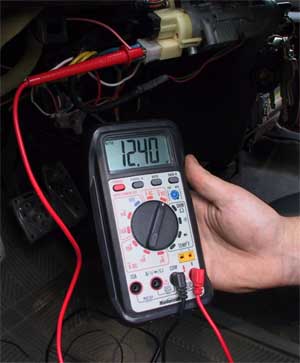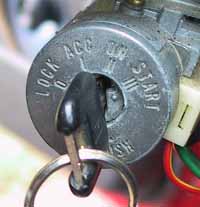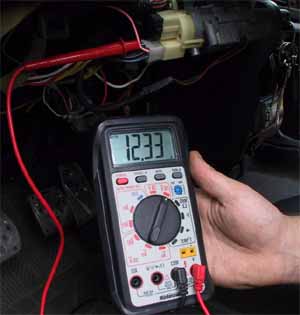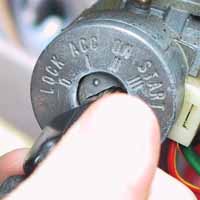

 |
 |
| [ TechGuys ] | [ Forum ] | Finding 12v Sources | [ Projects ] | [ How To ] | [ Email ] | [ Links ] |
Finding 12v Sources in a Car:When installing any electronic device in a vehicle, you will always be presented with the task of powering the device. This tech tip will help you find the following power sources:First, we will find a constant 12v sourceTo begin with, you will need a multi-meter (or other similar test unit; ie. a test light) If you do not have a multi-meter, we strongly suggest that you purchase one before any installations. If you do not know how to use a multi-meter, have a look at the tech tip which covers the use of a multi-meter.
- constant 12v source
- accessory source (voltage supply present when key is in the ignition, 1st position)
- ignition source (voltage supply present when key is in the ignition, 2nd position)
- cranking source (12v supplied only when starting/turning over the car's engine)
In all cases, we will be looking at the ignition wires for our 12v sources. For ease of explanation, shown below is an example:

figure 1
- point A
- This is the supply side of the ignition harness.
This supplies a constant 12v to the ignition switch.
- point B
- This is the switched side of the ignition harness.
This portion of the ignition harness is where we will focus our attention. A constant 12v supply is a source which supplies power when the key is either in the "off" position, or not present at all. Typical applications for a constant 12v source include some of the following:
A constant 12v supply is a source which supplies power when the key is either in the "off" position, or not present at all. Typical applications for a constant 12v source include some of the following:
- alarm system
- remote starter
- clock
- etc ..
To find a constant 12v source, you will use the positive probe (typically red) of your multi-meter. Start by grounding the multi-meter to a vehicle ground point (metal). Once the multi-meter is grounded, ensure that the ignition switch is in the "off" position. Once you are sure that the ignition is off, proceed to probe the wires on the switched portion of the ignition switch (refer to figure 1 above). When you probe a wire that supplies 12v you know you have found a constant 12v supply.

With the ignition switch in the off position, you should read approximately 12v on the multi-meter.
Next we will find the accessory source The accessory source is a switched source which supplies 12v when the key is in the accessory (first) position. Do note that in most cases, this supply will also provide 12v when the key is in the ignition (second) position. Typical application for an accessory source include some of the following low-current devices:
The accessory source is a switched source which supplies 12v when the key is in the accessory (first) position. Do note that in most cases, this supply will also provide 12v when the key is in the ignition (second) position. Typical application for an accessory source include some of the following low-current devices:
|
|
To find the accessory source, start by ensuring that the ignition switch is in the "off" position. Insert the positive probe in any connection (except the constant 12v source).Thirdly, we will find the ignition (on) sourceThe next step will be to turn the key to the accessory position. Be sure not to turn the key too far at this point. If you have selected the proper source, you will now read a positive voltage source (around 12v).

With the ignition switch in the off position, you should not read any voltage on the multi-meter.
Test the results by turning the ignition off, then back on. If the voltage drops to zero, then back to 12v when the key is in the accessory position, you have found the accessory source. 
If you do not read 12v (approx.) on the multi-meter when the key is in the accessory position, this indicates that you must have selected either the ignition or the cranking source. To find the accessory source, try a different probe position and repeat the above steps.
 The ignition source is the most common source when dealing with electronic devices which require lots of current. When a car is running (engine on) the ignition (on) source is live (supplying 12v). You can however use ignition switched power when the car is not running but the key is in the ignition (on) position. The ignition (on) source should be used when dealing with high-current applications which include some of the following:
The ignition source is the most common source when dealing with electronic devices which require lots of current. When a car is running (engine on) the ignition (on) source is live (supplying 12v). You can however use ignition switched power when the car is not running but the key is in the ignition (on) position. The ignition (on) source should be used when dealing with high-current applications which include some of the following:
|
|
To find the ignition (on) source, start by ensuring that the ignition switch is in the "off" position. Insert the positive probe in any connection (except the constant 12v source).Lastly, we will find the cranking sourceThe next step will be to turn the key to the ignition (on) position. If you have selected the proper source, you will now read a positive voltage source (approximately 12v).

With the ignition switch in the off position, you should not read any voltage on the multi-meter.
Test the results by turning the ignition to the accessory position, then back to the ignition position. If the voltage drops to zero when in the accessory position, then back to 12v when the key is in the ignition position, you have found the ignition source. 
If you do not read 12v (approx.) on the multi-meter when the key is in the ignition (on) position, this indicates that you must have selected either the the cranking source. To find the ignition source, try a different probe position and repeat the above steps.
 The final source is a switched source which provides 12v only when the engine starter is being engaged. This supply is generally only used by remote starters and alarm systems in which case the ignition switch is bypassed and the electronic device is acting as the ignition switch for the cranking position. To find the cranking source, start by ensuring that the ignition switch is in the "off" position. Insert the positive probe in any connection (except the constant 12v source).
The final source is a switched source which provides 12v only when the engine starter is being engaged. This supply is generally only used by remote starters and alarm systems in which case the ignition switch is bypassed and the electronic device is acting as the ignition switch for the cranking position. To find the cranking source, start by ensuring that the ignition switch is in the "off" position. Insert the positive probe in any connection (except the constant 12v source).

With the ignition switch in the off position, you should not read any voltage on the multi-meter.
The next step will be to turn the key to the cranking (start) position. If you have selected the proper source, you will now read a positive voltage source (around 12v) only while turning the key to the cranking (start) position.
Test the results by releasing the key, then turning the key back to the cranking (start) position. If the voltage drops to zero when the key is released, then back to 12v when the key is in the cranking (start) position, you have found the cranking source. 
If you do not read 12v (approx) on the multi-meter when the key is in the cranking (start) position, this indicates that you must have selected either the ignition or the cranking source. To find the accessory source, try a different probe position and repeat the above steps.
Still confused? Email us here
If you feel that this article has been of any use to you, please consider supporting the website by making a small donation. For more info, simply click on the "Make a Donation" icon and you will be brought to a donation info page. Thanks!
| [ TechGuys ] | [ Forum ] | Finding 12v Sources | [ Projects ] | [ How To ] | [ Email ] | [ Links ] |
(c) Copyright 2019 - James Buck - www.techguys.ca